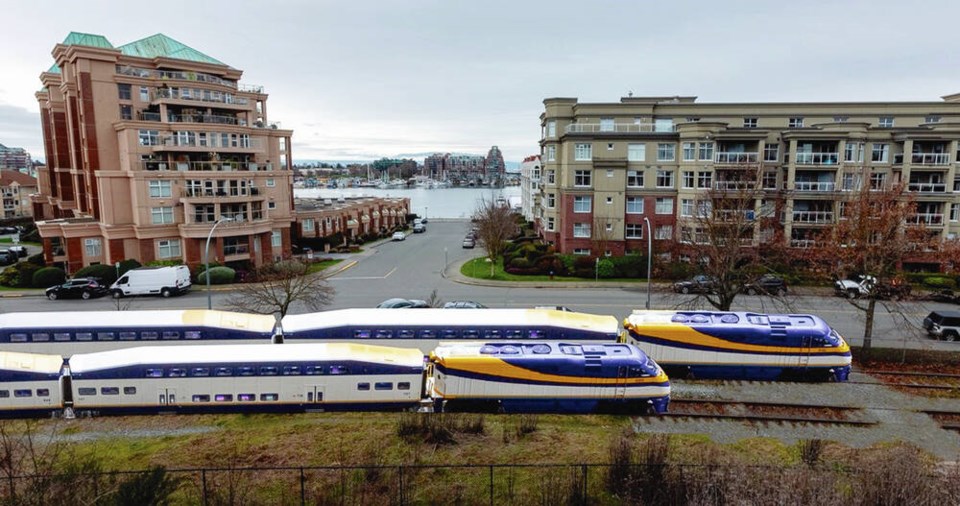In January 2002, the Times Colonist published my commentary: “Making the case for the E&N railroad.” Back then, the railway was facing abandonment following NorskeCanada (now Catalyst) switching shipping from its Port Alberni mill from rail to truck.
First Nations, business leaders, community advocates, and elected officials argued there was a compelling case for revitalizing rail. They cited a growing population, traffic and environmental issues, and the destructive alternative of highway expansion.
But they also pointed out that rail could only deliver on its potential if it were to benefit from the same public investment that highways have long enjoyed. And which had driven business off the tracks.
Now, some 20 years later, the Island Corridor Foundation has done that, with its Vancouver Island Rail Initial Business Case. And the $431 million it is seeking is modest compared with the reported $1 billion-plus the Ministry of Transportation and Infrastructure has estimated to “fix” just the Malahat.
The province, with federal government partnership, must get on board with the ICF plan. For the very same issues, identified in 2002, are becoming worse.
There are more traffic delays and closures, many of which are caused by increasingly severe weather like last November’s torrential rains. The Island’s population is expected to reach nearly one million by 2038, according to B.C. Population Estimates and Projections, so how is the resulting transportation demand going to be handled?
Environmentally, rail produces fewer greenhouse gases than road for passengers and freight. And, according to the ICF, “just one locomotive can haul a tonne of goods more than 220 kilometres on a single litre of fuel, while removing upwards of 300 trucks from our congested roads.”
Trains will draw people from their cars and freight from long-haul trucks. We have had many private conversations with potential business customers who are likely come to onside but only once the governments have invested in the railway.
Trains will also foster smart green development. Already, there are signs of rail-supporting investments happening, like the new Langford Station Cultural District, the rail-adjacent Starlight Stadium, and the new apartments near Parksville Station.
The Island’s rail system could also help solve Canada’s supply chain issues. There is talk about Port Alberni providing much-needed relief to Vancouver’s severe port congestion, with containers loaded onto railcars and ferried over.
The benefits are realizable due to the conservative, prudent, step-by-step plan outlined by the ICF. The planned passenger service departing multiple times a day that will permit commuting to work or for appointments as well for visiting family and friends, and for tourism.
The new trains will not be the old Dayliners. They will comprise of modern low-emissions locomotives and the same type of Canadian-designed-and-built long-proven multi-deck railcars as on the West Coast Express, which are easily accessible and bike-friendly. ICF has planned for the whole corridor to support active transportation, such as rails with trails. It also foresees intermodal connections with buses and ferries.
The ICF has also opened the door to private excursion trains. The Island has untapped rail tourism potential, magnified by our proximity to the Metro Vancouver and Seattle and Portland-area markets as well as from the cruise ships.
A $431-million investment to renew (not build anew) the railway, as written and vetted by experienced industry professionals and consultants, truly is a bargain price. Imagine what it would cost to build the railway from scratch.
We cannot abandon this amazing asset and then realize, as the great Canadian artist Joni Mitchell put it, “You don’t know what you got ’til it’s gone.” Those who call for the abandonment of rail for a trail should realize that rail gets passengers — and cyclists — to their destinations virtually all the time, on schedule, and no matter the weather.
It is critical to the success of this project, as the ICF has stated, that the provincial and federal governments acknowledge and work toward reconciling the historical wrongs with the First Nations.
Bottom line: the benefits of rail create a return on investment that far exceeds what the ICF is seeking in order to get the trains rolling.
What are we waiting for? Let’s bring the Island’s trains back on track.
>>> To comment on this article, write a letter to the editor: [email protected]



